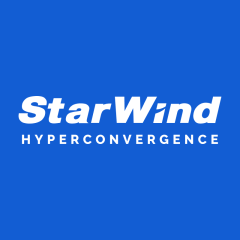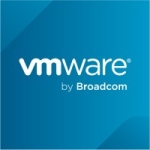What is our primary use case?
I'm a value-added reseller for Microsoft. I do some other stuff on these HCAs too, but that's the easiest way to describe it.
I'm providing a remote workspace for a special, select subgroup of clients who are running a pretty specific product called Infor. I'm pretty experienced with hosting and supporting this particular product, so I decided to also wrap a value-added reselling business around it so that I could give them a full remote workspace, instead of just support for their product.
We're running virtualized workloads for 300 or 400 users at this point. Our goal is to have them log in every day in and run all of their day-to-day work on these virtualized workloads.
How has it helped my organization?
The solution has probably saved me 100 hours of implementation work.
In terms of support, we're probably on the low end of requirements because we don't have a lot of advanced stuff going on. We just have virtualized workloads, so once they're configured they're done. But we've had a couple of longer support cases, and over the course of a month, it has saved me, on average, six to eight hours. That's as a one-man shop. If we grow and we start adding more HCAs, I imagine that that time saved increases pretty linearly. The support is really a convenience. I could always schedule my own time to take care of issues, but if there's a minor storage or networking issue, it's nice to bring someone in.
The major way it has changed our organization is that we came from a four-node, pure Microsoft setup, where we were using Storage Spaces Direct. StarWind is able to run on two nodes, so the hardware cost is quite a bit lower. They include support, so I don't need to keep someone on call in order to handle storage issues. And the fact that they were able to over-spec us for a reasonable price has meant that, over the past six months, I haven't had to worry about overhead and I haven't had to worry about budgeting any more systems. We have enough headspace to expand another 50 percent or so before I'll ever need to invest in direct processing hardware again. And when I do decide to invest more in hardware, I'm perfectly confident that they would just ship us a ready-to-go unit that can be plugged in with three cables and it's off and running.
What is most valuable?
I have burned a lot of time in the past configuring stuff like this myself, so the ability to pay a little bit of extra money to have something like this delivered, where all of the failovers are already configured, and all of the converged storage is already configured, and it's really just a blank slate to start building Hyper-V workloads on, is valuable. The fact that it's preconfigured and that there is a high level of support, so that I don't need to hire someone in order to do all this, has been my favorite feature.
Also, the hardware footprint is great. We've got two 2U servers which replaced four 2U servers. Granted, they were about three years old at that point, but we actually increased our processing capacity by about 50 percent while keeping our storage capacity about the same. We've actually been able to downgrade to a half rack from a full rack because we've gotten rid of some of our network equipment and some of our additional storage arrays. And the fact that that's all contained within 4Us of space is a complete 180 from the strategy we had before, which was four processing units and a few storage arrays. It's cut down on the amount of cabling we have to deal with by about 80 percent, so it's been a pretty big deal for the data center on the physical side of things.
The improved performance has scaled pretty well with the cost. I wouldn't say that the cost of performance is significantly lower. The main benefit is the cost of configuration and ongoing support. We're probably not saving a significant amount on hardware costs, but if I'm saving some 50 percent of my troubleshooting and hardware support time, we're probably saving, as a rough ballpark figure, $10,000 a year. If I were to hire even a part-time person to take care of just the hardware stuff that I'm now not having to take care of, it would be well over $10,000 a year to have a hardware architect available.
In addition, StarWind HCA has increased redundancy for us. Early on, just a couple of months into the tenancy, we had a pretty major hardware issue with one of the hosts, to the point where it was rebooting a few times a day. That was actually all Dell EMC's fault and had nothing to do with StarWind. Even with that host going up and down several times a day, there was only a little bit of inconvenience during the lag time when a live migration occurred from one server to the other, and we were up and running that entire time. We didn't incur any direct downtime over the course of a week-and-a-half where, literally, 50 percent of our processing units were going down three or four times a day. As frustrating as that experience was, it really helped strengthen my faith in StarWind solutions.
What needs improvement?
That situation, where Dell EMC servers were going down, has been my only real difficulty. I do understand that we were using refurbished Dell EMC hardware, so that may have played into the difficulties we were having. But at the end of the day, it ended up being something that the wider audience of Dell EMC was actually aware of as an issue. Neither the StarWind technicians nor the Dell EMC technicians were able to actually identify that problem sooner than a week or so. I found after, doing my own diagnosis and my own technician work, that there was actually a solution out there that many people Dell EMC's forums were aware of. The communication between Dell EMC support and StarWind support, in that particular scenario, left something to be desired, for me.
I did express those concerns to StarWind and they were very responsive to that. They seem to really appreciate the feedback. I'm hoping that there has been a change that has already been enacted by them as a result.
For how long have I used the solution?
We installed in March of this year, so we're relatively new. I believe we got refurbished, seventh-generation HCAs.
What do I think about the stability of the solution?
The stability has been great, with the exception of that one issue I mentioned which seemed to be Dell EMC hardware-specific. That even spoke to StarWind's stability in the sense that we had one host going down regularly without downtime.
We've had zero issues directly caused by StarWind. Everything is contained within the VM guests. Those are just configuration and Windows Server problems. This is definitely the most stable hardware we've had, and I've been involved in this business for eight years, on various stages of hardware. These past six months have been the lowest in terms of overhead so far.
What do I think about the scalability of the solution?
The scalability seems really good. I haven't hit the need for scalability yet, but it seems to scale pretty linearly with the exception of storage.
The idea is that all the storage is needed between all the hosts. So if we needed to increase our processing capacity, that would scale perfectly linearly. We would spend another X dollars to increase our capacity by 50 percent with an identical server.
I haven't explored storage capacity yet because we're a pretty low-storage-capacity company. But it seems like, with their additional products that aren't HCAs, their storage arrays, that you would be able to increase storage capacity on level with your costs as well. So you're not incurring a lot of overhead for interconnectivity or additional redundancy. At least that's my impression.
At the moment we're probably at 60 or 80 percent capacity across the board in all system resources, including networking. It's a really even 60 or 80 percent. If we can grow the business by another half next year, we'll be at 100 percent capacity. At that point, it would start making a lot of sense to look at adding another host because, if one fails and we have to fail over, we would effectively need to throttle everyone backed by 50 percent.
How are customer service and technical support?
We don't use the proactive part of support a whole lot but that's really because we're a very simple setup at the moment. They've come to me a couple of times when they noticed some things going wrong, but that's usually when I'm in there reconfiguring things or rebooting servers. When our proactive support expires we'll probably renew because of the fact that they've been really on top of issues, whether or not I've already been aware of them.
The part where support has really saved a lot of time is not really directly due to the proactive part of it. It has had to do with the fact that when I do need help, if storage is running slower, or if I see that there's some kind of memory-usage issue on the hosts, they're usually back to me in probably half an hour, at the very most, with a solution.
The main thing I've enjoyed from them is the really fast response when I do need help with reconfiguring or the like. I actually just reached out last week to try and make some networking changes. I got a response in about five minutes and I had an actual solution, with an advanced-tech ready to help me, within about 30 minutes. I don't know if that has anything to do with the proactive part of their support but I would imagine — putting myself in their shoes — that having a customer who is part of proactive support probably accelerates their response a little bit.
I've been really impressed with StarWind so far. They've been really helpful.
I haven't had to talk to StarWind at all for about a month. The last thing was a major networking upgrade request and I was really pleased with their response time. From a small-shop perspective, this is probably the best experience I've ever had in terms of the backing hardware for the services we provide. It's been very nice.
Which solution did I use previously and why did I switch?
The solution this replaced was all home-brewed. It was all running on a Windows Server. We had a backplane connected to a few different storage area network arrays. It worked well but it incurred quite a bit of overhead just to manage it. If you've ever heard of people working with just Microsoft Failover Cluster Manager with backplanes, it was a bear, both to physically connect and to manage.
The concept of an HCA was actually kind of new to me, at the time. We had been under the practice of putting processing and volatile memory on one box and putting all of our storage into other boxes. That introduced some issues with single points of failure: If your switch fails then your storage is done and if your network switch fails then your communication is done.
I had started researching Microsoft Storage Spaces Direct, which I believe was a new feature in 2016. StarWind must have a lot of search engine optimization related to Storage Spaces Direct, because they ended up coming up, really early, as an alternative. They're very active on Spiceworks and they were constantly in threads about Storage Spaces and putting their product out there. I ended up researching them and the total cost of ownership, hardware-wise, was possibly a little bit higher than bringing up your own, but the fact that support and configuration were included in that price, made it a slam-dunk for us.
How was the initial setup?
The implementation was fairly simple.
I had a really big, heavy pair of Dell EMC server boxes delivered to my workplace. I had to schedule some time to go physically into the data center, which is hosted two miles away from my office. The entire installation procedure was really a matter of unbox, throw the rails in, throw the servers on the rails. Each server then needed two power cords and two SFP connections between the servers themselves. And, bare minimum, they need one management connection to whatever your local Cat 5 switch is. That was it. That was really all that that needed to be configured, hardware-wise.
Once those were up and running, we spent maybe 45 minutes just getting the initial Hyper-V configuration done, and I was off and running. I was able to create and migrate VMs at will. No downtime, no reconfiguration, and literally nothing else.
All together it took about two hours for completely setting up the hardware and getting Hyper-V ready to create guests.
We didn't have an implementation plan. Physically, we had room in our racks and spaces for the power supplies and the cables. The only planning was that I gave StarWind a half-day's heads-up that I was going to get everything installed. They were on the phone and on a remote support session at pretty much the minute that I was ready to do the software side of things.
I enlisted some help to get things physically installed. Once that was done, it was just me and one StarWind engineer. We had to be on the phone for about an hour in total over that entire process. It was just me and that one person. They seem to have their process petty down pat. He was flying through the configuration and I was just sitting in the back seat watching.
What was our ROI?
We haven't seen ROI yet because we're a pretty low-sales company. We're just sticking with who we have at the moment because we need some more people who are experienced with this Infor product in order to grow the business much. I would expect that we will break even with our hardware investment within the first quarter of the coming year.
That's not bad at all because that will end up being almost right at the one-year mark. Even if we had to throw those servers in the trash at that point we would be at zero loss.
What's my experience with pricing, setup cost, and licensing?
In terms of the hardware pricing, we ended up going with refurbished machines because we're not in quite as critical a situation as other service providers may be. The pricing is pretty comparable between StarWind and other solutions, if you're just talking about hardware and a general support plan. The value starts to come back in a very real way with StarWind when you talk about the reliability of both the hardware and the support structure itself.
Our entire package was around $35,000 for everything, including three years of support.
Which other solutions did I evaluate?
We evaluated other options and, overall, the thing that made us go with StarWind was really the community involvement, mostly on Spiceworks. They're on Reddit too. Seeing how active they were in proactive troubleshooting and in answering sales questions for whoever was asking was a big deal. The fact they had extra manpower to handle that kind of stuff speaks really well to how efficient their support structure is.
What other advice do I have?
Look long and hard at your current hardware. There is a significant utility in sticking with a single vendor for stuff like this. If you are at that point where you need to refresh pretty much your entire environment, or a significant portion of it, I would say you should seriously look at StarWind because they would potentially be able to take care of just about everything, hardware-wise, as long as you're a small enough shop and you're ready to really commit.
Up until implementation, in March of this year, we were very reliant on ourselves and sub-contractors to support the hardware configuration and make sure everything was up and running. We had to be super-proactive about being on top of Microsoft issues because anything that is 100 percent reliant on Microsoft can go completely haywire if the wrong Windows Update runs. So the biggest change, and the biggest thing that we learned, is that it's nice to be able to rely on an external company, as long as they know what they're doing. We've been able to call StarWind for anything to do with the framework we're built on or anything to do with the substrate that Hyper-V is running on, no matter what happens, and know they're going to take care of it.
I'm the only one dealing with administration or maintenance of the HCA and it will probably stay that way, just for security concerns. It's a lot easier to stay compliant if I'm the only person that can do any of that. We do subcontract to other people for support of our customer VMs, but that's a whole different game. That's all built on the StarWind framework.
StarWind is an easy 10 out of 10.
Which deployment model are you using for this solution?
On-premises
Disclosure: PeerSpot contacted the reviewer to collect the review and to validate authenticity. The reviewer was referred by the vendor, but the review is not subject to editing or approval by the vendor.













